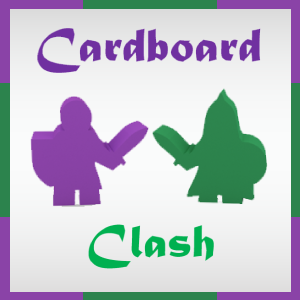Thank you for checking out my seventeenth review. My aim is to focus on reviewing board games and how they play for two people and, on occasion, how they play for one person. Because my wife is my primary gaming partner, a lot of consideration goes into finding those games that play well with 2 players, and we typically prefer to find those games that do not require a variant (official or otherwise) in order to play it with just the two of us.
**Giveaway ended – congratulations to Brian Dau, the winner of a free copy of Yokohama!
An Overview of Yokohama
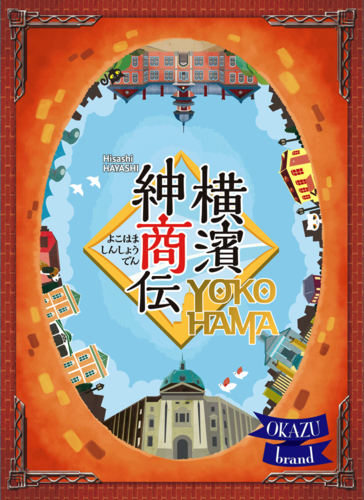
Once Yokohama was just a fishing village, but now at the beginning of the Meiji era it’s becoming a harbor open to foreign countries and one of the leading trade cities of Japan. As a result, many Japanese products such as copper and raw silk are collected in Yokohama for export to other countries. At the same time, the city is starting to incorporate foreign technology and culture, with even the streets becoming more modernized. In the shadow of this development was the presence of many Yokohama merchants.
Yokohama is a game designed by Hisashi Hayashi and is published by Tasty Minstrel Games. The box states that it can play 2-4 players and has a 90 minute play time on the box.
In Yokohama, each player is a merchant in the Meiji period, trying to gain fame from a successful business, and to do so they need to build a store, broaden their sales channels, learn a variety of techniques, and (of course) respond to trade orders from abroad.
Setup and gameplay for 2 Players
While the gameplay is the same regardless of player count, there are quite a few things that remain in the box for a two player game. The back of each location tile and management board provides a helpful guide, as the ones used in 3 and 4-player games are marked on the back accordingly. So you’ll set any of those back in the box, which should leave you with 10 location tiles and 4 management boards to use with two. You’ll shuffle those location tiles and make a pyramid, starting with 1 tile at the bottom and progressing up to a row of 4 tiles at the top. The score-tracking board should be set out with the 4 management boards nearby. Shuffle the three decks of achievement cards and place a card from the A deck, a card from the B deck, and a card from the C deck on the card outlines on the scoring board.
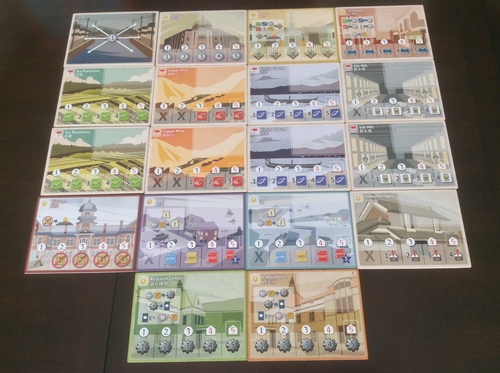
Shuffle the Order cards and place 16 back in the box. Then, deal two order cards to both players. Each player will select one to keep and remove the other from the game. Place six order cards from the top of the deck onto the Port management board. Shuffle the technology cards and place the top six cards on the Laboratory management board. Shuffle the building site cards and place one face-up in the top left corner of each location tile. Randomly place a 5-power token face-up on the 5-power spot on each location tile. Give each player a copper, a silk, a tea, and a fish token. The starting player will take 3 yen, the other player will have 4 yen. Each player will start with their President pawn, 8 assistant cubes, and 2 shophouses. The remaining assistant cubes, shophouses, and trading houses should be placed in the corresponding spots on their player’s board. Finally, a neutral-colored assistant cube is placed on the spot marked with the 2-Player icon on the Church and Customs management board.
There are six parts to each player’s main turn, and a few additional actions that can be done during the first or second half of a turn (before or after the six main turn actions). the main actions are:
Placement Step where a player puts out either 3 assistant cubes on 3 different action spaces, or 2 cubes onto the same action space.
Movement Step where a player does one of three things: takes their President Pawn from their playing area and puts it on the board where they have at least 1 assistant cube; moves their President Pawn from one space to another, so long as there is at least one assistant cube in each space they pass through as well as at least one on the space they end at (note: a player cannot end on a space where the other player’s President Pawn is located, but they can pass through the space by paying their opponent 1 yen); or they can remove the President Pawn from the board and return it to their playing area.
Area Action Step where a player activates the ability of that location, adding up the number of assistant cubes, shophouses, trading houses, and their President Pawn to determine the power level of that action (a number between 1-5). Typically, the higher the number the stronger or more effective the action is. An easy way to remember is to count everything on that space of your color.
5-Power Bonus step where a player can take the 5-power bonus token if they are the first person on that space to reach 5 power during a single action. These bonuses range from additional resources, yen, or imported goods.
Build a shophouse or trading house where a player whose action power was at least 4 can take a shophouse or trading house they have purchased and place it on one of the spaces on the building site card. Each card can hold only one shophouse of each color, and only one total trading house. They would then collect the reward that their house covered, and as an added bonus those count toward your total power on future actions on that space.
Recovery step where a player returns any assistant cubes on the action space to their supply.
This is the essence of what you can do during a game. The extra actions are to complete an order, to use a foreign ambassador (it is used like a President, only it does not add to the power of the location nor is it restricted by an opponent’s President Pawn), or fulfill an achievement card on the scoring board. Any goods or resources needed for the achievement are not spent, but an assistant cube is placed on the card thus reducing the number of them in your available pool for the rest of the game.

There are many other gameplay elements that could be discussed, but others have done far better than I could. So I’ll conclude this aspect with how the game ends. The end of the game is triggered by one of these conditions being met:
1) A player has placed their eighth shophouse on the board
2) A player has placed their fourth trading house on the board
3) A 4th cube, including the neutral cube, is placed on the Customs management board (with more players, this number may be higher)
4) A 4th cube, including the neutral cube, is placed on the Church management board (with more players, this number may be higher)
5) The order card deck is empty and there is at least one empty space on the Port management board.
Points are scored based on position on the Church Board, position on the Customs board, value of technology cards, sets of country cards, unused foreign agent tokens, remaining yen, and remaining goods. The highest point total is the winner.
My Thoughts
 The first thing that I really enjoyed was how variable the setup of the game would be. While it isn’t as strong of a positive as I initially imagined, this is still a great thing. The locations will not appear in the same order each game. The bonuses for building your houses and doing the 5-power bonuses will change each game. The achievements will change. This helps prevent the game from being a stale exercise in trying to be the most efficient at executing the same exact path each time. However, in a 2-player game the board is small enough that the arrangement of the spaces doesn’t impact your overall strategy.
The first thing that I really enjoyed was how variable the setup of the game would be. While it isn’t as strong of a positive as I initially imagined, this is still a great thing. The locations will not appear in the same order each game. The bonuses for building your houses and doing the 5-power bonuses will change each game. The achievements will change. This helps prevent the game from being a stale exercise in trying to be the most efficient at executing the same exact path each time. However, in a 2-player game the board is small enough that the arrangement of the spaces doesn’t impact your overall strategy.
 The movement aspect of this game is great. I love that you need to arrange paths via your assistants in order to move around and that you’ll need to stockpile them on spaces in order to take the stronger actions. It is a game with planning and strategy in abundance, and in a 2-player game you’ll almost always be able to get around to where you are wanting to go as long as you plan ahead on making the paths.
The movement aspect of this game is great. I love that you need to arrange paths via your assistants in order to move around and that you’ll need to stockpile them on spaces in order to take the stronger actions. It is a game with planning and strategy in abundance, and in a 2-player game you’ll almost always be able to get around to where you are wanting to go as long as you plan ahead on making the paths.
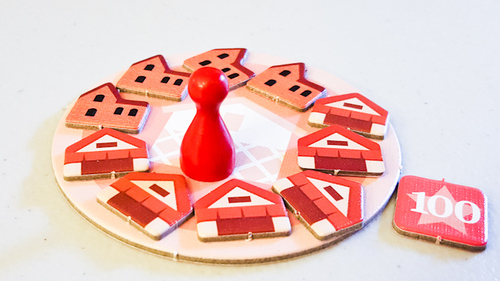
 The power aspect of this game is also another area of design I really like. Most spaces you’ll always be able to do the action if you can get there via movement, but if you want to be efficient with your action you need to plan ahead and load up enough assistants on a space. Pooling them too soon can cue your opponents in on what you are trying to accomplish, allowing them a chance to potentially block you by going there first or stopping in your path. You also need to get at least 4 power in order to place a shophouse or trading house, making extra incentive to get just enough power in there to add that benefit from your move.
The power aspect of this game is also another area of design I really like. Most spaces you’ll always be able to do the action if you can get there via movement, but if you want to be efficient with your action you need to plan ahead and load up enough assistants on a space. Pooling them too soon can cue your opponents in on what you are trying to accomplish, allowing them a chance to potentially block you by going there first or stopping in your path. You also need to get at least 4 power in order to place a shophouse or trading house, making extra incentive to get just enough power in there to add that benefit from your move.
 I really like that claiming an achievement, or cashing in on the Church or Customs management boards takes one of your available assistants from your pool. It makes you either plan ahead to free more workers from your warehouse, or else leaves you scrambling to make long enough paths and pooling enough power to be effective.
I really like that claiming an achievement, or cashing in on the Church or Customs management boards takes one of your available assistants from your pool. It makes you either plan ahead to free more workers from your warehouse, or else leaves you scrambling to make long enough paths and pooling enough power to be effective.
 I like a game with set collection in there, and this one works nicely. There are dual incentives here: each pair of country symbols gives you a foreign agent (which is worth either an extra “president” action in a turn, or else 1 VP at the end of the game), but collecting a set of 4-5 different countries scores you higher amounts of VP at the end of the game. With one of those five countries being really rare, that makes it no sure thing that you can get all five countries or be able to do so multiple times. The fact that they are represented on both order cards and technology cards is another great implementation of design.
I like a game with set collection in there, and this one works nicely. There are dual incentives here: each pair of country symbols gives you a foreign agent (which is worth either an extra “president” action in a turn, or else 1 VP at the end of the game), but collecting a set of 4-5 different countries scores you higher amounts of VP at the end of the game. With one of those five countries being really rare, that makes it no sure thing that you can get all five countries or be able to do so multiple times. The fact that they are represented on both order cards and technology cards is another great implementation of design.
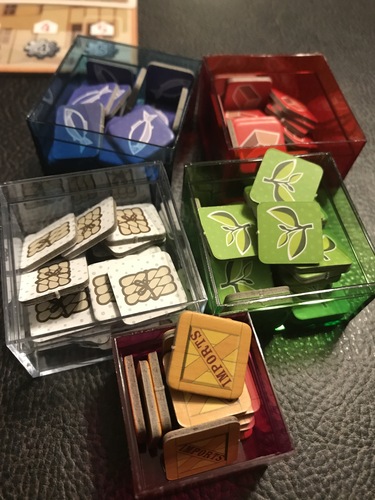
 I love, love, love the multiple ways to trigger the end of the game. This game doesn’t only provide several ways to score points, but also multiple ways to bring about its end. Several of those are dependent on your own actions, but there are a few that are impacted by everyone (running out the orders deck, placing cubes on the management boards). In a 2-player game, with the automatic inclusion of a neutral cube that counts toward the limit on the management boards, this could potentially end really quickly. We’ve had it triggered by all of the possible outcomes so far, and every time we feel like it was the perfect length for the game.
I love, love, love the multiple ways to trigger the end of the game. This game doesn’t only provide several ways to score points, but also multiple ways to bring about its end. Several of those are dependent on your own actions, but there are a few that are impacted by everyone (running out the orders deck, placing cubes on the management boards). In a 2-player game, with the automatic inclusion of a neutral cube that counts toward the limit on the management boards, this could potentially end really quickly. We’ve had it triggered by all of the possible outcomes so far, and every time we feel like it was the perfect length for the game.
 The game looks very overwhelming when set up, but it takes only a turn or two to realize that this is a very simple and easy-to-understand game. Especially with two players, the number of options out there are not too high because a lot of the locations have similar effects (collect X of a resource, purchase X by paying Y, etc.). The board is perfect in size and is far less busy than it initially appears. It also takes less time to understand how things work in terms of how to gain what you need and how to turn things into points for a game.
The game looks very overwhelming when set up, but it takes only a turn or two to realize that this is a very simple and easy-to-understand game. Especially with two players, the number of options out there are not too high because a lot of the locations have similar effects (collect X of a resource, purchase X by paying Y, etc.). The board is perfect in size and is far less busy than it initially appears. It also takes less time to understand how things work in terms of how to gain what you need and how to turn things into points for a game.
 The iconography of the game does take some time to get used to. Some space actions are simple, showing a good or VP to collect. Others, like the icons on the Laboratory, take some referencing in the book to really wrap your head around the action and/or limitations from that space. These are a small barrier at first during the first plays, but with familiarity they become easier to interpret and integrate into part of the experience.
The iconography of the game does take some time to get used to. Some space actions are simple, showing a good or VP to collect. Others, like the icons on the Laboratory, take some referencing in the book to really wrap your head around the action and/or limitations from that space. These are a small barrier at first during the first plays, but with familiarity they become easier to interpret and integrate into part of the experience.
 In a 2-player game, it never really feels like I am blocked out of what I want to do. Even when an opponent is where I want to go, I know that they will be moving the next turn so I can get there one move later. The board is small enough that I can get anywhere without having to pay the opponent so long as I plan ahead effectively. So while many worker placement games place a value on being the first player so you can get the action you need each turn, this one focuses more on the long-term route planning. You’ll almost always be able to get done what you want, and usually waiting just means you can make it, or another space, more effective while being delayed. With more players, this could very well change but I suspect it would still be similar enough in experience.
In a 2-player game, it never really feels like I am blocked out of what I want to do. Even when an opponent is where I want to go, I know that they will be moving the next turn so I can get there one move later. The board is small enough that I can get anywhere without having to pay the opponent so long as I plan ahead effectively. So while many worker placement games place a value on being the first player so you can get the action you need each turn, this one focuses more on the long-term route planning. You’ll almost always be able to get done what you want, and usually waiting just means you can make it, or another space, more effective while being delayed. With more players, this could very well change but I suspect it would still be similar enough in experience.
 The theme is unique and represented well. Art is a subjective thing, and while the appearance of everything in this game is solid, it isn’t memorable. You can definitely get the feeling of being a merchant trying to collect and ship goods, but it isn’t super-immersive. Few worker placement games are immersive in theme, and they tend to touch upon the more unique themes like this one. If you care about beautiful, memorable art or a really immersive theme, this one won’t leave the impression you are looking for. However, it doesn’t feel like the theme is pasted on nor is the artwork detracting.
The theme is unique and represented well. Art is a subjective thing, and while the appearance of everything in this game is solid, it isn’t memorable. You can definitely get the feeling of being a merchant trying to collect and ship goods, but it isn’t super-immersive. Few worker placement games are immersive in theme, and they tend to touch upon the more unique themes like this one. If you care about beautiful, memorable art or a really immersive theme, this one won’t leave the impression you are looking for. However, it doesn’t feel like the theme is pasted on nor is the artwork detracting.
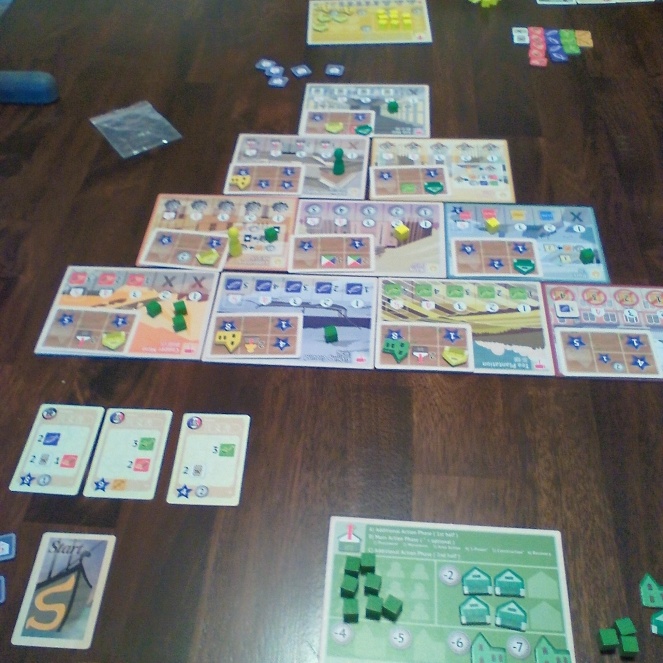
Final Verdict
This was a game that surprised me a lot. I wasn’t sure what to expect, but knew its worker placement aspect was unique enough to make it worth checking out. Many people want to compare it to Istanbul, and after my first play I thought I no longer needed to obtain Istanbul for my collection. After a few more plays, though, I realized that it is a very different game from Istanbul and in a good way. It does several things that I really enjoy, such as the power system, the use of assistants for movement paths, and the multiple end-game triggers.
The one thing that I was really disappointed in was the variability of the game. Yes, it will be set up differently each game. But each of the three achievement spots has only four cards to choose from. Many of the 5-power tokens are similar in what they provide. The building site cards are very similar in the rewards offered for building your shophouses and trading houses. So ultimately, the variability is not as earth-shattering as it might sound in the beginning. That isn’t a bad thing, but it also means that the games will still feel very similar each time you play. Which is the same thing that could be said for Istanbul, and many other worker placement games out there. The path toward victory is similar each game, even if the way you choose to pursue that changes slightly based on what appears and where they appear for the game.
I definitely recommend this game for anyone seeking an unique gaming experience from a designer whose name I’m suddenly seeing everywhere. This is a really solid game, and should last through quite a few plays before it runs any risk of feeling like you’ve exhausted what the game has to offer. It is a solid 2-player experience that is certain to improve with higher player counts, but even if added to a collection that would never see more than 2-players this game is definitely worth picking up.
Thanks again to Tasty Minstrel Games for providing this game for review, as well as their generous offer to provide a copy to give away.
Check out more of our reviews at the following Geeklist and be sure to let me know what you thought of this game.
https://www.boardgamegeek.com/geeklist/220300/cardboard-clas…
